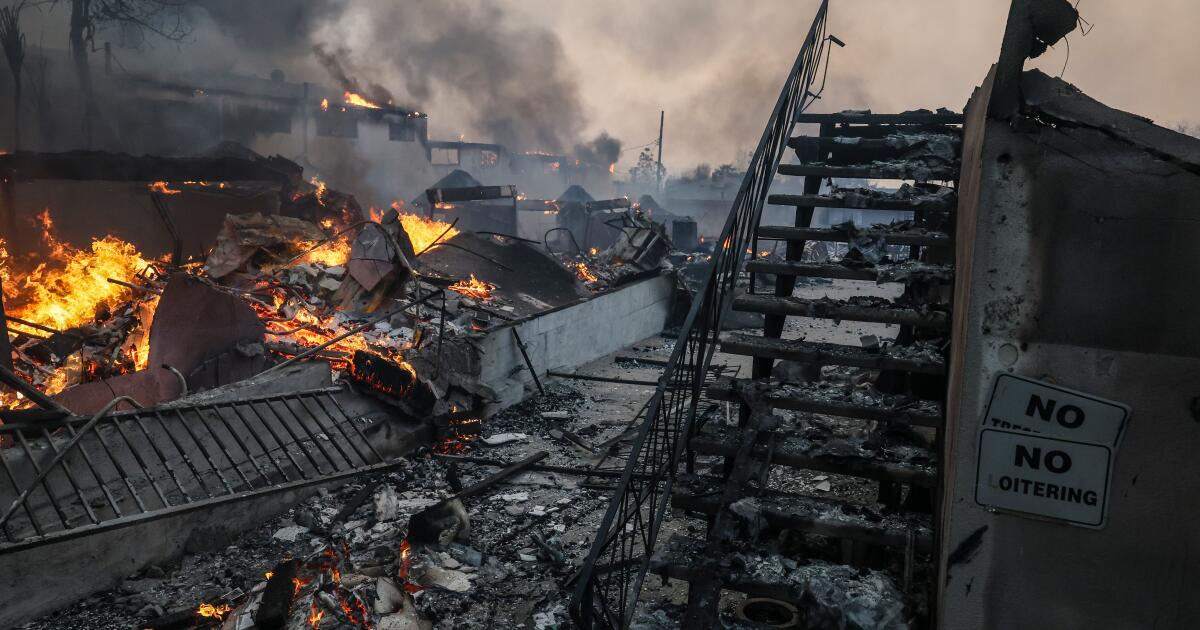Edison’s plan to pay Eaton fire victims could mean less litigation, less compensation
Southern California Edison’s plans to compensate Eaton fire victims for damage were met with skepticism Thursday from lawyers representing Altadena residents, but drew tentative support from others who say the initiative could help shore up the state’s $21-billion wildfire fund.
The utility announced its Wildfire Recovery Compensation Program this week, saying it would be used to quickly pay victims, including those who were insured, while avoiding lengthy litigation.
The announcement comes as state officials consider ways to shore up the state’s fund to compensate wildfire victims, amid fears that it could be fully exhausted by Eaton fire claims. Fees that attorneys receive as part of victim settlements could further strain the fund.
State Sen. Henry Stern (D-Calabasas) said Edison’s new program may have some merit as potentially “a more efficient way” than lawsuits to make sure victims are fairly compensated.
He pointed out that lawyers were “coming across the country to represent” Eaton fire victims. “Are they really getting their money’s worth when they pay 30% to these lawyers?” Stern asked.
Mark Toney, executive director of the Utility Reform Network, said Edison’s program had the potential to reduce costs that otherwise must be covered by the wildfire fund, which was established in part by a surcharge on the bills paid by customers of Edison, Pacific Gas & Electric and San Diego Gas & Electric.
“If Edison is determined to be the cause of the fire, anything they can settle early reduces the costs that otherwise would be paid later,” Toney said.
The utility has released few details of how the program would work, leaving victims who are already coping with uncertainty with more questions. And lawyers who had been seeking to represent victims in lawsuits against Edison were quick to urge caution.
“Without admitting fault or providing transparency, Edison is asking victims to potentially waive their rights,” said Kiley Grombacher, one of dozens of lawyers involved in litigation against Edison for the Jan. 7 wildfire that killed 19 and destroyed 9,000 homes in Altadena.
According to Edison, the program would be open to those who lost homes or businesses as well as renters who lost property. It would also cover those who were harmed by smoke, suffered physical injuries or had family members who died.
“People can file a claim even if they are involved in active litigation,” said Kathleen Dunleavy, an Edison spokeswoman.
Dunleavy said the company would be releasing more information soon, including on eligibility requirements.
At a Thursday meeting in Sacramento of the Catastrophe Response Council, which oversees the wildfire fund, officials said they were creating criteria that Edison must follow in designing the program, including having measures to prevent fraud and clear eligibility standards.
Sheri Scott, an actuary from Milliman, told the council that the firm estimated that losses from the Eaton fire ranged from $13.7 billion to $22.8 billion.
“We heard from our guest today that we might run out of money very quickly,” said Paul Rosenstiel, a member of the council appointed by Gov. Gavin Newsom.
He urged state lawmakers to consider changing the law that created the fund so that less money was at risk of flowing to third parties who aren’t fire victims.
PG&E created a program to directly pay victims of the 2021 Dixie fire, which burned more than 960,000 acres in Northern California. It created a similar program to compensate victims of the 2022 Mosquito fire, which burned nearly 77,000 acres in Placer and El Dorado counties.
PG&E said it offered Mosquito fire victims who lost their homes $500 per square foot and $9,200 per acre for those whose lots did not exceed 5 acres. To aid in rebuilding efforts, victims who decided to reconstruct their homes were eligible for an additional $50,000.
Lynsey Paulo, a PG&E spokeswoman, said in an email that the company paid nearly $50 million to victims of the Dixie fire through its program. That money went to 135 households, she said.
“PG&E’s program was designed to provide claimants with resources to rebuild as quickly as possible and help communities recover,” she said.
Richard Bridgford, a lawyer who represented Dixie fire victims, said that PG&E’s offer was lower than victims won through lawsuits, and that only a fraction of those eligible for the PG&E program decided to participate, he said.
”Victims have uniformly done better when represented by counsel,” said Bridgford, who now represents victims of the Eaton fire.
Edison’s announcement of its program came as fire agencies continue to investigate the cause of the Eaton fire. Edison said in April that a leading theory is that a dormant transmission line, last used in 1971, somehow was reenergized and sparked the blaze. The company says the new compensation program “is not an admission of legal liability.”
“Even though the details of how the Eaton Fire started are still being evaluated, SCE will offer an expedited process to pay and resolve claims fairly and promptly,” Pedro Pizarro, chief executive of Edison International, the utility’s parent company, said in a news release. “This allows the community to focus more on recovery instead of lengthy, expensive litigation.”
The utility said it had hired consultants Kenneth R. Feinberg and Camille S. Biros, who had worked on the September 11th Victim Compensation Fund, to help design the program.
If Edison is found responsible for the fire, the $21-billion state wildfire fund would reimburse the company for all or most of the amounts paid to victims through the new program or through lawsuits and insurance claims.
Half of the fund’s $21 billion came from charges to electric bills of customers of Edison, PG&E and SDG&E. The other half was contributed by shareholders of those three companies, which are the only utilities that can seek reimbursements from the fund.
